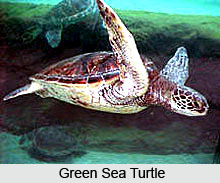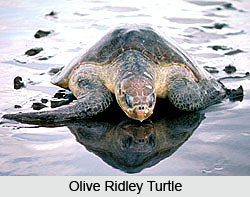 In the eastern region of India, there is no dearth of national parks, reserves and sanctuaries. Gahirmatha Marine Wildlife Sanctuary is truly a significant one. It is situated in Orissa, nicely cushioned by Bhitarkanika, the second largest mangrove forest region of India. Gahirmatha Marine Wildlife Sanctuary is the site of the world`s leading congregation of sea turtles.
In the eastern region of India, there is no dearth of national parks, reserves and sanctuaries. Gahirmatha Marine Wildlife Sanctuary is truly a significant one. It is situated in Orissa, nicely cushioned by Bhitarkanika, the second largest mangrove forest region of India. Gahirmatha Marine Wildlife Sanctuary is the site of the world`s leading congregation of sea turtles.
It is established in the deltaic region of the rivers like Brahmani, Baitarani and Dhamra, which have their origin in the Chota Nagpur Plateau. As they reach the Bay of Bengal, they become slow, winding waterways, lodging nutrient rich silts along the network of brooks and inlets. This land, having a wet, tropical climate and rich rainfall, has an affluent biodiversity. This region is a mixture of mangrove, tropical forests, brooks, muddy tracts, grasslands, scrublands, sand beaches and seaward islands. Also exotic coastal beach of Gahirmatha lying on the eastern borders of stretches for nearly 30 km, adds to the beauty of the whole of reserve.
Gahirmatha Marine Wildlife Sanctuary is famous for the Olive Ridley Turtle of which more than half a million gather here between the months of December and April every year. Large numbers of turtles are drawn here directly from the sea and then drag to the coasts. They dig up the sand to lay their eggs, before skillfully covering them. Afterwars with the incoming tidal waves they return to their sea abodes. This seasonal event of their occasional arrival takes place at four main sites, the largest being at Gahirmatha Marine Wildlife Sanctuary, as discovered in the year 1974. Dr H R Bustard, a Food and Agricultural Organisation (FAO) consultant urged the Indian government to protect this unique nesting-ground. In the year 1975, a 672 sq km region of Bhitarkanika was acknowledged as a sanctuary. Then in the year 1988, a 1 45 sq km area was declared as a national park. Then, in the year 1997, a huge section of the sea areas of Gahirmatha and also the fringing coastal lands were acclaimed as a separate sanctuary, and also adjacent with Bhitarkanika.
In huge numbers, the tourists throng the region to enjoy the beauty and glory of the Gahirmatha Marine Wildlife Sanctuary. Apart from road links from cities like Cuttack and Bhadrak to Rajnagar and Chandbali in Bhitarkanika, one can also get in to the reserve in boat rides also. Habalikbati, Ekakula, Dangmal and Gupti bear witness to the uncommon and valuable preserves of wildlife of the sanctuary.
 A huge range of fish species is to be found in the waters together with the largest reptileof India, the rare Estuarine Crocodile. Water Monitor, numerous snakes, and mammals such as Spotted Deer, Wild Boar, Sambar and Fishing Cat are also found here. Mammals like Fishing Cat, Jungle Cat, Leopard-cat, Gangetic Dolphin, Striped Hyena, Smooch Indian Otter, Small Indian Civet, Spotted Deer (Chital), Sambar, Jackal and Indian Porcupine are found in abundance. Numerous reptiles, namely, Leatherback Sea Turtle, Olive Ridley Turtle, Green Sea Turtle, Hawksbill Sea Turtle, Estuarine Crocodile, Water Monitor, King Cobra can be seen near the water bodies.
A huge range of fish species is to be found in the waters together with the largest reptileof India, the rare Estuarine Crocodile. Water Monitor, numerous snakes, and mammals such as Spotted Deer, Wild Boar, Sambar and Fishing Cat are also found here. Mammals like Fishing Cat, Jungle Cat, Leopard-cat, Gangetic Dolphin, Striped Hyena, Smooch Indian Otter, Small Indian Civet, Spotted Deer (Chital), Sambar, Jackal and Indian Porcupine are found in abundance. Numerous reptiles, namely, Leatherback Sea Turtle, Olive Ridley Turtle, Green Sea Turtle, Hawksbill Sea Turtle, Estuarine Crocodile, Water Monitor, King Cobra can be seen near the water bodies.
There are almost two hundred bird species, and the Bagagahana heronry near Suajore Creek throngs with waterbirds. There is an impressive range of wintering waterfowl, waders (sandpipers, plovers, godwits and curlews), gulls and terns. One can also see the presence of some hunting birds. Among them, white -bellied sea Eagle, Peregrine Falcon, Osprey, Short-toed Eagle, Eurasian Marsh Harrier, Pied Harrier, Steppe Eagle, Greater Spotted Eagle are worth to note.
Aquatic birds like Great Cormorant, Darter, Great Egret, Grey Heron, Cinnamon bittern, Black Ibis, Spot-billed Pelican, Painted Stork, Asian Openbill, Lesser Adjutant, Stork-billed Kingfisher, Black-capped Kingfisher, Collared Kingfisher, Pied Kingfisher, cast a wonderful spell on the minds of the bird lovers.
Just like any other Indian national park, this park too came under the clutches of hunters and man made problems. Infact Olive Ridley Turtles, the main attraction, suffer a high mortality rate. Mechanized boats are the chief culprits, and perhaps small-scale fishing operations unwittingly cause fatalities. However the timely initiatives of the forest authority has saved the sanctuary from facing a grave danger in future times. For instance Operation Kachhapa has been launched for the protection of turtles. Also a non-mechanized fishing locale has been established, to monitor various sites of the reserve. Diligent efforts have been taken to create awareness amongst the natives from creating further damages.











